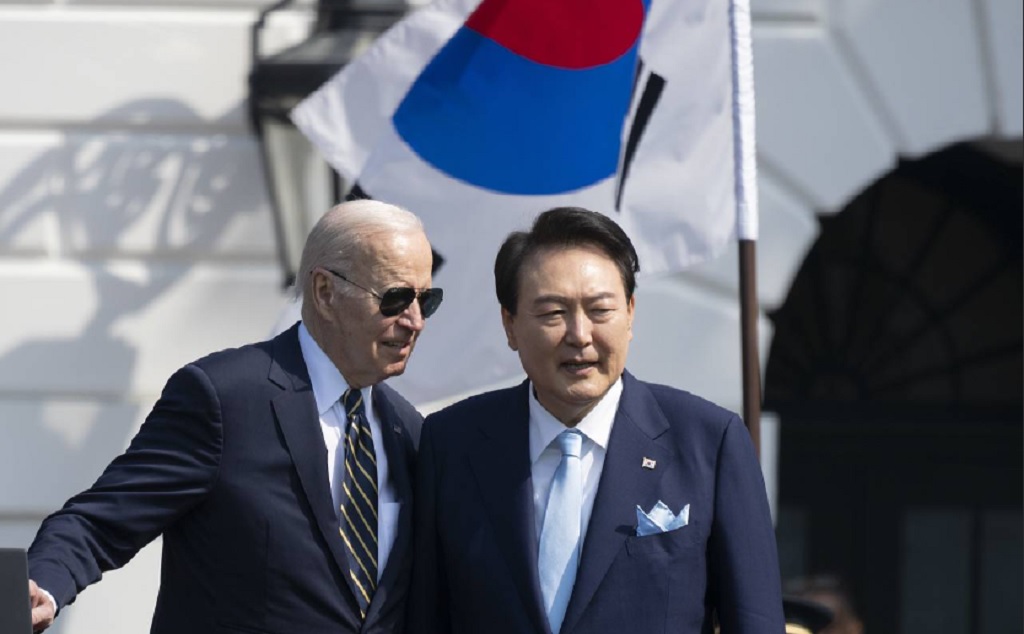On April 26, 2023 Presidents of The USA and Republic of Korea (ROK) signed so-called Washington Declaration.
The official visit marked the 70th anniversary of the U.S.-South Korean alliance. Steps announced in the Declaration could have an impact on the nonproliferation regime and the balance of power in the Asia-Pacific region.
First, the U.S. and South Korean presidents emphasize the global nature of the alliance. This means that South Korea will be more involved in the security policy of the Western powers’ bloc and the alliance’s capabilities can be exploited beyond the Korean peninsula. Yoon Seok-yeol has already become the first South Korean president to attend a NATO summit in 2022 to increase cooperation on cybersecurity and nonproliferation and information sharing. With the U.S. imposing a “new Cold War” policy on China, the Republic of Korea, despite its close ties with China, has probably opted for the U.S.. In the future, this choice may have a negative impact on relations with China.
Second, the U.S. and South Korea have agreed to expand nuclear cooperation. In response to the DPRK threat, the presidents announced the creation of a Nuclear Consultative Group to strengthen extended deterrence, discuss nuclear and strategic planning, and manage the threats to the nonproliferation regime. Strengthening the advisory bodies will be accompanied by a show of force. For the first time since 1981, U.S. nuclear-powered submarines with ballistic missiles on board (SSBNs) will visit South Korean ports. An «Ohio»-class SSBN is expected to visit South Korea in the near future.
The Washington declaration emphasizes that the reason for increased cooperation nuclear sphere is the nuclear threat from the DPRK. However, the practical significance of these steps to neutralize the threat from North Korea remains questionable. As Dr. J. Lewis of the Middlebury Institute of International Studies, these measures have «no military value».
Despite this, the declaration has symbolic value for bilateral relations. Moreover, it can be considered an element of the U.S.-China New Cold War and a demonstration of South Korea’s involvement in this confrontation.
A consensus has been reached?
The Washington Declaration of 2023 was intended to be a compromise in the nuclear deterrence relationship between the United States and the Republic of Korea. Its main achievement for the nonproliferation regime was the reaffirmation of the Republic of Korea’s commitment to the Treaty on the Non-Proliferation of Nuclear Weapons (NPT). This step is intended to reassure the world community against the background of Yoon Seok-yol’s statements about the desire to deploy US tactical nuclear weapons (TNWs) on the Korean Peninsula, as it was during the Cold War. With growing North Korea nuclear threat, the decision to develop its own, nuclear weapons according to the CHEY Institute of Advanced Studies, is supported by 75% of South Korea citizens.
President Yoon Seok-yeol’s statement about acquiring nuclear weapons, combined with South Korean public sentiment, caused serious concern in the United States. In 1991, U.S. TNWs were completely withdrawn from the Korean Peninsula. As the DPRK’s nuclear capabilities increased, South Korean citizens cast doubts about the effectiveness of the U.S. extended nuclear deterrent.
In the 1970s, President Park Chung-hee, against the backdrop of the North Korean threat, attempted to build nuclear weapons. The program was thwarted only by direct U.S. intervention. However, the country’s nuclear industry is well-developed. According to the PIR Center report “The New Nuclear Nine? Assessing the Threats of Nuclear Weapons Proliferation in the World,” the Republic of Korea is a threshold country.
In Washington declaration Seoul was able to address US growing concerns about South Korea nuclear status and secured a statement that «The ROK has full confidence in U.S. extended deterrence commitments and recognizes the importance, necessity, and benefit of its enduring reliance on the U.S. nuclear deterrent». Subsequently, to reinforce his position, J. Biden Jr. stressed that attempt of North Korea to conduct a nuclear strike against the U.S. and its ally «will result in the end of whatever regime [takes] such an action». Thus, a consensus between the interests of South Korean society and the U.S. administration was found in words.
However, the announced measures to strengthen bilateral cooperation in nuclear planning and the possibility of basing U.S. SSBNs are hardly positive from the point of view of the nonproliferation regime. Moreover, they blatantly ignore the interests of third countries, primarily China.
The Washington Declaration as an element of the “New Cold War”
The Cold War rhetoric in the case of the Washington Declaration have real grounds. The current stage of international relations is often characterized by the term “New Cold War” or “Cold War 2.0,” where the main antagonists are the United States and the PRC. The Korean Peninsula has an important geopolitical significance in this confrontation [1].
The U.S. Newsweek magazine, before the official summit between Yoon Seok-yeol and J. Biden Jr. called for the creation of an “East Asian NATO. As the Financial Times notes, the US decision to return SSBNs to the Korean Peninsula is also inspired by memories of the Cold War era. A similar arrangement existed between the US and NATO during the Cold War.
It is known that during the period of confrontation between the Soviet Union and the United States, U.S. submarines visited the Korean Peninsula until 1981. It was in Korea that the U.S. submarine first participated in combat operations after World War II. During the Korean War, 1950-1953; Tench-type submarines entered the war zone in enemy territory.
U.S. dominance in the maritime component during the Cold War was undeniable, which cannot be said for the New Cold War. China’s growing military power is a serious challenge to the U.S. “Free and Open Indo-Pacific” strategy. China’s military reform, which began in 2015, envisages the modernization of the army to the highest standards by 2049. As RAS Academician A.A. Kokoshin notes, dominance of the seas is a necessary condition for solving the problem of Taiwan and ensuring the sovereignty of the South China Sea [2].
In 2021, 8 destroyers with guided missiles on board joined the Chinese Navy. Experts are already referring to the start of a naval arms race in the region. In addition to the leading powers, regional powers are also involved. South Korea, despite its agreement with the United States on submarines, is not going to curtail its own program of diesel submarines KSS-III with six vertical launchers for SLBMs. The DPRK, for its part, has the largest submarine fleet in the world, which, despite its age, still poses a threat to U.S. and allied naval forces near the Korean Peninsula.
The naval arms race in the Asia-Pacific region is inextricably linked to the future of nuclear nonproliferation. Recent plans to supply U.S. nuclear submarines to Australia have seriously divided the nuclear powers. As Ambassador S. Duarte noted, the Indo-Pacific region is already a space with unresolved territorial disputes and potential hotbeds of military conflict. Therefore, the emergence of additional strike capabilities could have negative consequences.
Unlike the Australian scenario, the Washington declaration does not refer to the transfer of nuclear submarines to South Korea. Thus, the decision does not contradict the Treaty on the Non-Proliferation of Nuclear Weapons (NPT). However, PIR Center Expert Council member M.N. Lysenko believes that such steps contradict the spirit of the NPT and carry risks of a domino effect and may eventually lead to the appearance of nuclear charges on nuclear submarines. Furthermore, as the PIR Center report “The New Nuclear Nine?” notes, although South Korea has abandoned enrichment technology and does not possess full nuclear fuel cycle technology, “Access to the most sensitive elements of the NFC could also be obtained through the creation of nuclear submarines. Thus, despite the low practical relevance of stationing an SSBN in South Korea to combat the DPRK, this move could result in the intentional or unintentional transfer of information useful for the military nuclear program to South Korea.
The expansion of U.S.-South Korean consultation mechanisms on nuclear deterrence could also have negative consequences. The Global Times has already reacted to the Washington declaration, calling the hidden side of it a focus on China. It is argued that such declaratory measures may have negative consequences for security on the Korean Peninsula and in the Asia-Pacific region. For example, in 2016 under the pretext of the North Korean threat, elements of the U.S. missile defense system THAAD were deployed in South Korea, whose radar, according to China, can track Chinese ICBM launches.
***
The Washington Declaration is a landmark document in the 70-year history of the U.S.-ROK alliance. It underscores the global significance of this partnership, signaling South Korea’s expanding role in international security.
In addition, the declaration was an attempt to reach consensus in the difficult U.S.-South Korean nuclear deterrence relationship. The U.S. succeeded in getting the Republic of Korea to declare its commitment to the NPT and its full confidence in the U.S. extended nuclear deterrent. The move was intended to reassure South Korean public opinion, a large part of which favors the country’s nuclear status and nonproliferation advocates who fear this scenario.
However, the measures used as a “carrot” have only a symbolic meaning for dealing with the nuclear missile threat from the DPRK and, according to the PRC, have an implicit anti-Chinese orientation. First, the summit is a demonstration of South Korea’s drift towards U.S. position on international issues, despite its historical ties with China. Taking into account U.S.-led AUKUS and Quad current event makes block confrontation, reminiscent of the Cold War era, more evident in the Asia-Pacific. Second, given the New Cold War and the naval arms race in the Asia-Pacific Region, the anticipated deployment of American SSBNs on the Korean Peninsula will have a destabilizing effect in U.S.-Chinese relations. The deployment of strategic missile-carrying submarines, whose advantage is stealth for North Korea, which has the world’s largest submarine fleet, is of no practical use. Third, South Korea is a threshold state. Increased nuclear cooperation with the United States carries the risk of deliberate or inadvertent transfer of sensitive information that could be used to pursue its own nuclear program.
[1] Kalinin R.R. The Korean Peninsula as a Hotbed of Cold War 2.0. Lomonosov World Politics Journal. 2022;14(4):48-76. (In Russ.) https://doi.org/10.48015/2076-7404-2022-14-4-48-76
[2] Kokoshin A.A. Voennaya reforma v KNR: voenno-strategicheskie, politicheskie i organizacionno-upravlencheskie aspekty [The Military Reform in the PRC: Strategic, Political, Organizational and Administrative Aspects] // Mezhdunarodnaya zhizn’. 2016. № 12. Pp. 47−67. (in Russ).
Key words: NPT; Nuclear nonproliferation; Korea
NPR/NPT


